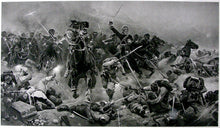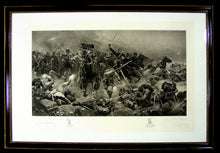The Moonlight Charge of the Household Cavalry, Kassassin, 1882, Circa 1883
Adding product to your cart
Overall: 75cm (29.5in) x 109cm (42.75in)
A signed artist's proof copy with remarque portraits of Generals Wolseley and Graham, published 1884 by the Fine Art Society, New Bond Street, London. Signed in pencil lower left and right and inscribed and dated March 1886. In period ebonised and gilt wood glazed frame. Accompanied by an autograph letter signed from the artist.
Provenance:
Gift of the artist Richard Caton Woodville to General Sir Henry Ponsonby, G.C.B., P.C., (1825-1895), Private Secretary to Queen Victoria
Read more
The Moonlight Charge of the composite regiment of the Household Cavalry took place on 28 August 1882. It became the most celebrated action of the British military intervention in the nationalist revolt against the Khedive Tewfik. The Egyptians led by Colonel Ahmed Urabi had attacked British troops under General Graham at Kassassin in order to recapture the Suez Canal. The outcome of the battle hung in the balance as night fell, whereupon reinforcements in the form of the composite regiment of the Household Cavalry, the 7th Hussars and the Royal Horse Artillery, arrived and went immediately into action. By moonlight they cut their way through the Egyptian infantry to reach a battery of guns.
The London Gazette reported: ‘By this time the moon had risen. Squadrons showed up black, and flash answered flash as the opposing guns opened one on the other. The order now came to charge, and away went the Household Squadrons led by the gallant Ewart. Into the Egyptian infantry and up to the guns they went, the 7th following as a solid reserve in hand, but a little of this work was enough for the enemy, and they evaporated in all directions.’
Richard Caton Woodville, Jr., (1856-1927) was an arch imperialist and, like other successful Victorian artists, a national celebrity. The Boy's Own Paper claimed 'he is pretty generally admitted to hold the leadership of all English military painters'. Considered a good fellow, sportsman and womaniser, he spoke with a German accent, sported a waxed moustache, rode to hounds, fished, hunted big game in India and Morocco, and duelled in the Balkans. He studied at the Düsseldorf school of painting under the Prussian military artist Wilhelm Camphausen, and then Eduard von Gebhardt, before briefly studying in Russia and then Paris under Jean-Léon Gérôme.
Versed in military matters as a member of the Berkshire Yeomanry, he went to Egypt in 1882 as both artist and reporter for the Illustrated London News, and afterwards exhibited the pictorial results at the Fine Art Society in 1883. His painting The Moonlight Charge at Kassassin met with public and critical acclaim and crucially was noted with approval in royal circles as Queen Victoria herself had specially requested the inclusion of the Household Cavalry in the expeditionary force. Such recognition was to prove especially advantageous to the twenty-seven year-old artist's career, as the Queen's favourite son, Prince Arthur, had also served in the campaign. Consequently in 1883 Caton Woodville produced by Royal Command The Guards at Tel-e-Kebir (Royal Collection).
Sir Frederick Ponsonby, the recipient of the present artist's proof, was Queen Victoria's trusted Private Secretary and Keeper of the Privy Purse. As is evident from the accompanying A.L.S., he was thus an influential contact at court. In the summer of 1885 Caton Woodville was asked to produce a painting of the wedding of the Queen's youngest daughter, Princess Beatrice (1857-1944) to Prince Henry of Battenburg, hence the request made the following year in the accompanying letter for fifteen minute sittings with the Queen and the royal couple so that he might record their likenesses.
In several ways Caton Woodville and Ponsonby were opposites. The former, a dapper continental adventurer, was a noted ladies' man whose divorce cost him a knighthood. The latter, an English gentleman of striking appearance yet a scruffy dresser, was a family man happily married to one of Queen Victoria's maids of honour, He turned down a peerage in 1880. Caton Woodville was enthralled by the exploits of the British Army whereas Ponsonby who had served in the trenches with Grenadier Guards before Sebastopol was a liberal in politics and a vociferous advocate of army reform. Ponsonby died at Osborne, I.O.W., having successfully tempered the Queen's enthusiasm for her drunken Highland servant John Brown, and to some extent her Indian 'secretary', the Munshi. Caton Woodville blew his brains out in his London studio in 1927 while of unsound mind.
Sources:
Dennison, M. (2009) The Last Princess, the devoted life of Queen Victoria's youngest daughter, Griffin
Dictionary of National Biography (2004–14) Ponsonby, Sir Henry Frederick (1825–1895), courtier by H. C. G. Matthew, Oxford University Press








